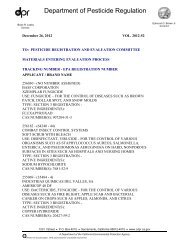Dichlorvos (DDVP) Risk Characterization Document - California ...
Dichlorvos (DDVP) Risk Characterization Document - California ...
Dichlorvos (DDVP) Risk Characterization Document - California ...
You also want an ePaper? Increase the reach of your titles
YUMPU automatically turns print PDFs into web optimized ePapers that Google loves.
II. INTRODUCTION<br />
The human health risk assessment has been conducted for the active ingredient dichlorvos (<strong>DDVP</strong>)<br />
because of adverse effects in oncogenicity, genotoxicity, and neurological studies. <strong>DDVP</strong> is listed<br />
under <strong>California</strong> Proposition 65, the Safe Drinking Water and Toxic Enforcement Act of 1986, as a<br />
chemical known to the State of <strong>California</strong> to cause cancer.<br />
A. CHEMICAL IDENTIFICATION<br />
<strong>Dichlorvos</strong> (2,2-dichlorovinyl dimethyl phosphate, <strong>DDVP</strong>) is an organophosphate pesticide. It is<br />
effective against aphids, spider mites, caterpillars, thrips, and white flies. The major use is for space<br />
treatment of food processing, handling, and storage plants; feedlots; stockyards; corrals; holding<br />
pens; animal buildings; poultry houses; as well as commercial and institutional buildings. The only<br />
"direct" food uses are on beef and dairy cattle skin to control insects, as post-harvest treatment of<br />
processed commodities, and in the greenhouses for tomatoes, radishes, lettuce, and cucumbers.<br />
<strong>DDVP</strong> is also used in homes for insect control. Tolerances are established for the use of <strong>DDVP</strong> in raw<br />
agricultural and processed commodities (Appendix A).<br />
The primary biological activity for <strong>DDVP</strong> is through its inhibition of cholinesterase (ChE) enzymes.<br />
ChEs are a family of enzymes found throughout the body that hydrolyze choline esters. In the<br />
nervous system, acetylcholinesterase (AChE) is involved in the termination of impulses across nerve<br />
synapses including neuromuscular junctions by rapidly hydrolyzing the neural transmitter,<br />
acetylcholine. Inhibition of AChE leads to accumulation of acetylcholine in the synaptic cleft which<br />
results in over-stimulation of the nerves followed by depression or paralysis of the cholinergic nerves<br />
throughout the central and peripheral nervous systems. AChE is highly selective, although not<br />
exclusively, for acetyl esters as substrates (Brimijoin, 1992). Another form of cholinesterase,<br />
butyrylcholinesterase (BuChE), preferentially hydrolyses butyryl and proprionyl esters, depending on<br />
the species; however, it will hydrolyze a wider range of esters, including acetylcholine (Brimijoin,<br />
1992). Unlike AChE, the physiological function of BuChE is not known. Although AChE and BuChE<br />
are found in most tissues, their ratio varies from one tissue to another and from one species to<br />
another. In rats, AChE is the predominant form of ChE in the central nervous system and in the<br />
neuromuscular junctions of peripheral tissues such as the diaphragm, skeletal muscle, heart, and<br />
spleen (Gupta et al., 1991; Mendoza, 1976). AChE and BuChE are present in roughly equal<br />
proportions in the liver and kidneys of rats. Non-synaptic AChE is also present to a lesser extent in<br />
peripheral tissues; however, its function is not known (Brimijoin, 1992). Non-synaptic AChE is<br />
essentially the only ChE present in erythrocytes of higher animals. BuChE is the predominant form of<br />
ChE in the plasma of humans; however, the ratio of AChE to BuChE varies greatly from species to<br />
species and between sexes. For example, the AChE:BuChE ratio in human plasma is approximately<br />
1:1000, but closer to 1:2 in female rats and 3:1 in male rats.<br />
In acutely toxic episodes, muscarinic, and nicotinic receptors are stimulated by acetylcholine with<br />
characteristic signs and symptoms occurring throughout the peripheral and central nervous systems<br />
(Murphy, 1986). Peripheral muscarinic effects can include increased intestinal motility, bronchial<br />
constriction and increased bronchial secretions, bladder contraction, miosis, secretory gland<br />
stimulation and bradycardia. Peripheral nicotinic effects include muscle weakness, twitching, cramps<br />
and general fasciculation. Stimulation of muscarinic and nicotinic receptors in the central nervous<br />
system can cause headache, restlessness, insomnia, anxiety, slurred speech, tremors, ataxia,<br />
convulsions, depression of respiratory and circulatory centers, and coma. Death is usually due to<br />
respiratory failure from a combination of peripheral and central effects.<br />
<strong>DDVP</strong> appears to be more selective for insects than for mammals (van Asperen an Dekhuijzen,<br />
1958). The inhibition by <strong>DDVP</strong> of mouse brain ChE was reversible while the inhibition of fly head ChE<br />
was irreversible. <strong>DDVP</strong> also had higher affinity for fly head ChE than for mouse brain ChE. Sustained<br />
atmospheric <strong>DDVP</strong> concentration as low as 0.015 ug/liter (L) is effective for fly and mosquito control,<br />
but 0.15 ug/L is required for 100% kill in 30 minutes (WHO, 1967).<br />
4
















